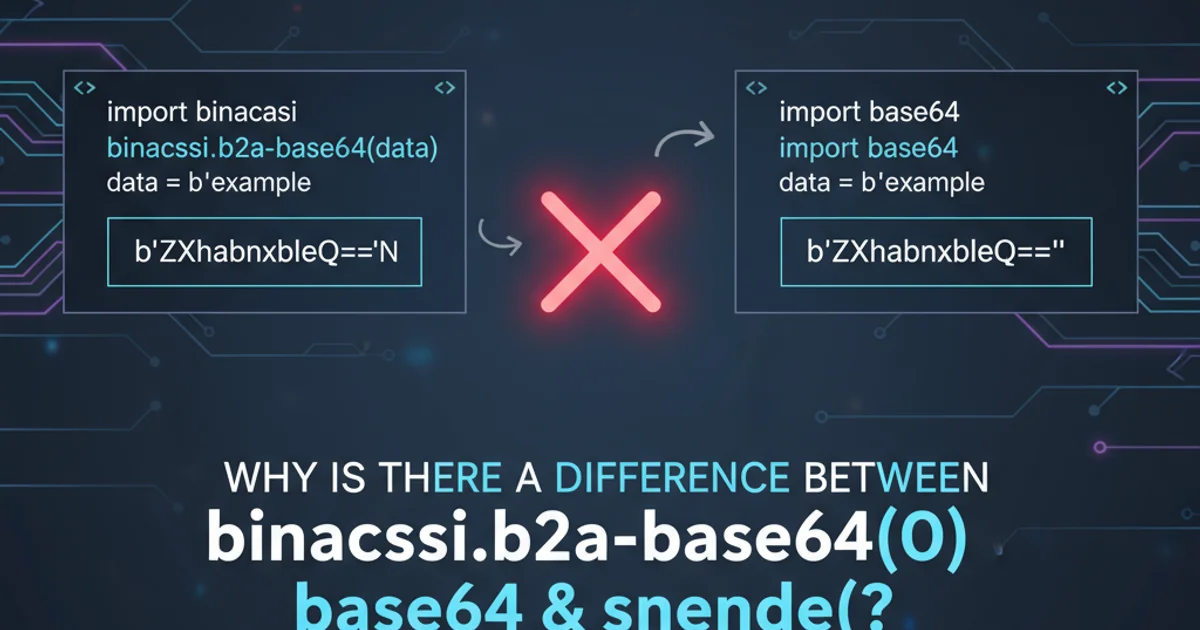Why is there a difference between binascii.b2a_base64() and base64.b64encode()?
Categories:
Understanding the Differences: binascii.b2a_base64() vs. base64.b64encode() in Python 2.7

Explore the subtle but significant distinctions between Python's binascii.b2a_base64() and base64.b64encode() functions, focusing on their output and newline handling in Python 2.7.
When working with Base64 encoding in Python 2.7, developers often encounter two primary functions: binascii.b2a_base64() and base64.b64encode(). While both achieve Base64 encoding, they exhibit a crucial difference in their output format, specifically regarding newline characters. Understanding this distinction is vital for ensuring compatibility and correctness in data transmission and storage. This article will delve into these differences, provide practical examples, and explain why one might be preferred over the other in various scenarios.
The Core Difference: Newline Characters
The most significant difference between binascii.b2a_base64() and base64.b64encode() lies in their handling of newline characters. By default, binascii.b2a_base64() appends a newline character (\n) to its output, making it suitable for line-based protocols or files where encoded data is expected to be terminated by a newline. In contrast, base64.b64encode() produces a raw Base64 encoded string without any trailing newline, which is often more desirable for embedding encoded data directly into other data structures or protocols that manage their own line breaks.
import binascii
import base64
data = 'Hello, World!'
# Using binascii.b2a_base64()
encoded_binascii = binascii.b2a_base64(data)
print 'binascii output:', repr(encoded_binascii)
# Using base64.b64encode()
encoded_base64 = base64.b64encode(data)
print 'base64 output:', repr(encoded_base64)
Demonstrating the output difference between binascii.b2a_base64() and base64.b64encode()
Running the above code snippet clearly illustrates the difference. The binascii output will include \n at the end, while the base64 output will not. This seemingly small detail can lead to parsing errors or unexpected behavior if not accounted for, especially when interoperating with systems that have strict expectations about Base64 string formats.
repr() when printing encoded strings to visualize non-printable characters like newlines, making it easier to debug and understand the exact output.When to Use Which Function
The choice between binascii.b2a_base64() and base64.b64encode() largely depends on the specific use case and the requirements of the system you are interacting with.
binascii.b2a_base64() is generally preferred when:
- Writing Base64 encoded data to a file where each encoded block should occupy its own line.
- Interacting with older protocols or systems that expect line-terminated Base64 strings.
base64.b64encode() is typically the better choice when:
- Embedding Base64 encoded data within JSON, XML, or other structured data formats.
- Sending Base64 data over network protocols (like HTTP) where the protocol itself handles framing and line breaks.
- When you need a 'raw' Base64 string that you can then manipulate or concatenate without worrying about extra newlines.
flowchart TD
A[Input Data] --> B{Encoding Requirement?}
B --"Needs Newline (e.g., file)"--> C[binascii.b2a_base64()]
B --"No Newline (e.g., JSON, HTTP)"--> D[base64.b64encode()]
C --> E[Output with \n]
D --> F[Output without \n]Decision flow for choosing between binascii.b2a_base64() and base64.b64encode()
Python 3 and Beyond
It's important to note that while this article focuses on Python 2.7, the base64 module in Python 3 has evolved. In Python 3, base64.b64encode() still produces output without newlines. The binascii module's b2a_base64() function also behaves similarly, appending a newline. However, Python 3's string handling (bytes vs. unicode) introduces other considerations. For new development, base64.b64encode() is generally the recommended and more flexible option, as it provides the raw encoded data, allowing you to explicitly add newlines if needed, rather than having them implicitly added.
binascii.b2a_base64() and base64.b64encode() expect bytes-like objects as input and return bytes. Ensure proper encoding (e.g., data.encode('utf-8')) before passing strings to these functions.